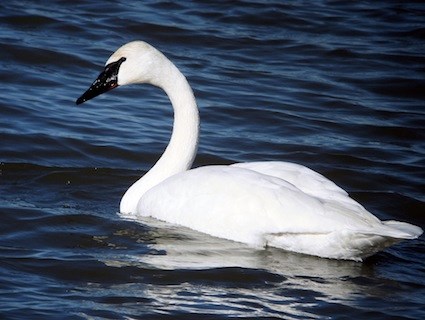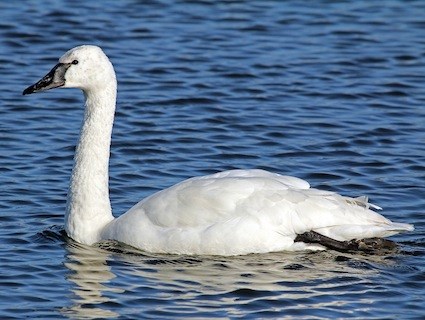Brief note, now is an excellent time to be observing waterfowl passing through Pool 8. We saw a pair of TRUMPETER SWANS hanging about all last week in the sloughs and just south of Goose Island (normally in twos, rather than a large group, and note the very large black bill. Wing spread can approach 10 feet!). The Audubon group confirms that indeed there are many more TRUMPETERS than normal on the Upper Missisippi this year. A small mob of PELICANS is clustering forlornly in the Bay just above Stoddard.

Trumpeter Swan
- Very large swan with all-black bill
- Long, sloping forehead
- © Laura Erickson, St. Louis, Missouri, February 2008
Similar Species: Tundra Swan

- © Douglas Caldwell, Toronto, Ontario, Canada, December 2011
From the Cornell Bird Lab: “Trumpeter Swans demand superlatives: they’re our biggest native waterfowl, stretching to 6 feet in length and weighing more than 25 pounds—almost twice as massive as a Tundra Swan. Getting airborne requires a lumbering takeoff along a 100-yard runway. Despite their size, this once-endangered, now recovering species is as elegant as any swan, with a graceful neck and snowy-white plumage. They breed on wetlands in remote Alaska, Canada, and the northwestern U.S., and winter on ice-free coastal and inland waters.”
(Trumpeter Swans are also found from St. Louis to N. Wisconsin! – Pat)
Additionally, among the many ducks seen between Goose Island and Genoa, are Lesser Scaup, Goldeneye, Common Merganser, Hooded Merganser, Canvas Backs, Bufflehead, and American Widgeon. Bring your bird book! My goal this spring has to get some of these sorted out with my binoculars and a little help from the Audubon Club. These are strikingly beautiful ducks!
Eagles continue to be prolific from the Twin cities south. Not unusual to see as many as 11 adults in sight on the ice. I’m also noting many juveniles still hanging about. They become dispersed once the ice melts, so enjoy them while you can. See an eagle nest? Look for the “balde” head of the adult sitting in it!


